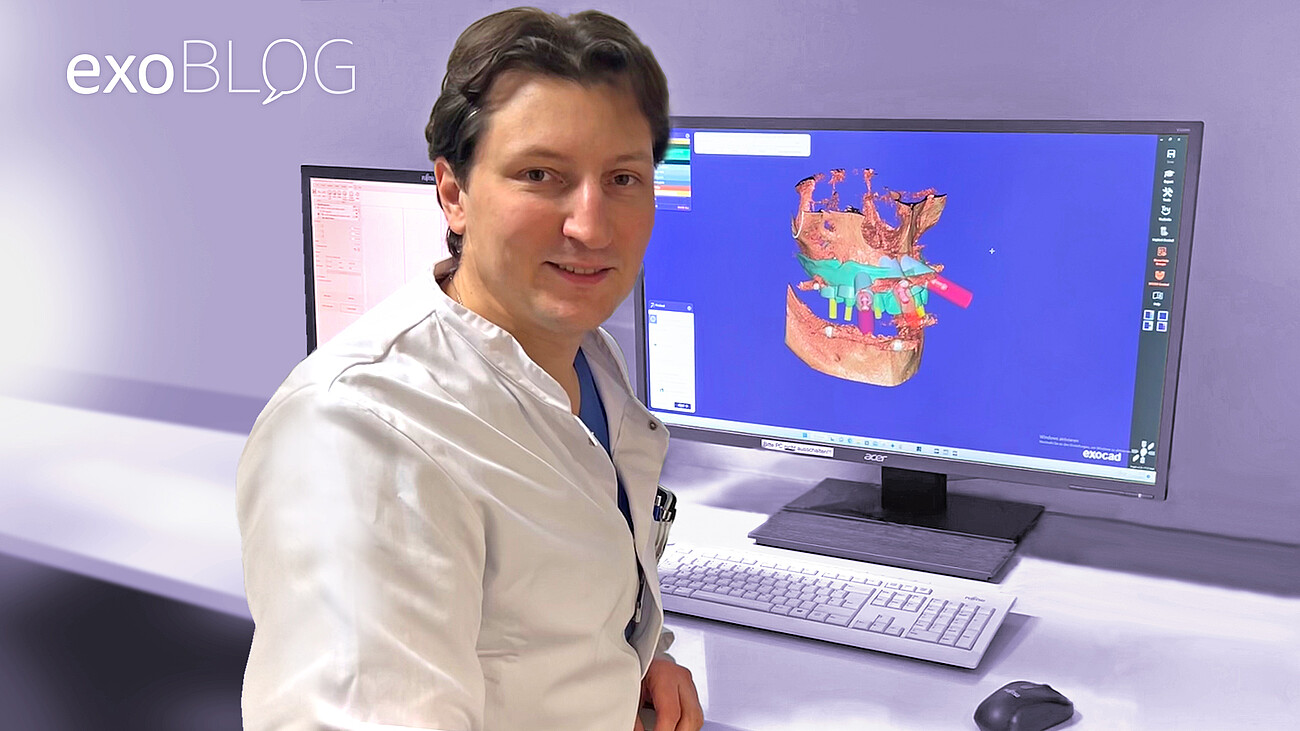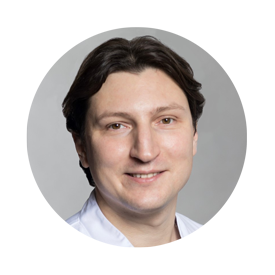Digital workflows at Charité Berlin
“We have a very special contingent of patients here,” says Dr. Alexey Unkovskiy, a prosthodontist at one of the largest teaching hospitals in Europe, Charité Berlin. “Most dental practices can only take on cases that allow the practice to still be financially sustainable—the cases that are too complicated to handle come to us.” Alexey’s preferred software to handle those complicated cases? exocad’s exoplan and DentalCAD software. He shares why these tools improve patient care and streamline communication with labs.
Q: What brought you to the dental field?
A: I ask myself that question too. My Mom is also a dentist, and she motivated me to look at the medical field. I landed here in the dental field, but I also perform a lot of surgeries. I combine classical dentistry—prosthetics with oral surgery. I like this interdisciplinary work.
Q: What types of cases do you handle at Charité Berlin?
A: We have really complicated cases, huge rehabilitations mostly. The head of my department, Professor Florian Beuer, is also president-elect of the German Association of Oral Implantology. He puts a big focus on dental implantology. It's a daily routine for us to not transfer patients to surgical departments but to perform all the surgery on our own within the walls of prosthetic department. That's why we handle these huge interdisciplinary cases with extractions, implant placement, and prosthetic planning using 3D backwards planning and smile design. We have some all-on-six, all-on-four—lots of interesting cases with digital immediate loading.
Q: When did you start using digital workflows?
A: In 2011, I started to make my literature review for my dissertation which was on the topic of maxillofacial prosthetics. I got to know 3D printing and scanning, but these protocols were not well defined and were not established at that extent of time. In 2013, I got started with maxillofacial prosthetics and used various types of software with basics like Meshmixer and ZBrush. In 2017, we had the opportunity at the University of Tübingen, where I was at the time, to use exocad. I started to perform splints, surgical guides, and common waxups using exocad.
“I like exocad because there is a possibility to switch from surgical planning scene to prosthetic scene in a matter of minutes.”
Q: Which exocad products do you use and how are you using them?
A: Almost all of them. There is a question in Germany as to where the border is between the field of dental technicians and dentists. From my point of view, it's quite normal practice for a dentist to perform waxups and do some basic technical work. Not to take work from the dental technician, but rather to help and develop the protocol and the fusion of dental techniques and prosthodontics. Most of the things I do, I start working with the patient on my own. I define the patient’s centric occlusal relationship, and I make the waxup with Smile Creator. I try it on the patient first. Then I start communicating with my dental technicians and send them the scene. That's why I like exocad because there is a possibility to switch from surgical planning scene to prosthetic scene in a matter of minutes. I just send my scene from DentalCAD, and the lab technician can make some refinements and start working from the place where I left off.
“I am a passionate user of exocad. I really like this fusion between surgery, the technical part and prosthodontics.”
Q: How has using exoplan impacted your work? How do you coordinate the workflow between exoplan and DentalCAD?
A: I am a passionate user of exocad. I really like this fusion between surgery, the technical part and prosthodontics. You can start with a waxup in DentalCAD and then transfer it to exoplan. Or vice versa—exoplan offers the ability to drive prosthetically the implant planning and import into DentalCAD. There is a certain flexibility with how you want to start. This is what I really like.
Q: Is there a case that has stayed with you?
A: The key case for me was in Tübingen one year before I moved to Berlin. It was a young guy with six single restorations in the upper jaw in the front region. He liked that we did everything digitally. We used digital workflows for the smile design, waxup and mock-up. We made a 3D scan of his face and sent all the waxups to his mobile phone so he could access everything remotely. This was a really nice communication between the patient, the lab and the doctor. It was a real game-changing case for me.
Q: How does the software assist in the communication process between you and the lab? What’s your digital workflow?
A: I take a lot of 2D clinical photographs every time the patient is seated in the chair. I think this is very important for the full protocol to be able to perform the smile design. You can start with a 3D design of the face but in most cases, 2D photos are enough for Smile Creator. I 3D print the waxups so that they can be retouched and assessed. This also helps me communicate with the patient about the proposed smile design. I only start to communicate with the lab after I’ve completed the mockup and adjusted it already—the shape, the length of the teeth, the ratio—and scan it once again as a reference for provisionals.
Q: It sounds like this workflow helps validate your objective for the restoration and streamline the communication process.
A: It’s very nice because I think you don’t need to waste the time of the dental technician for this stuff. It's manageable by the dentist if he or she possesses enough digital tools. This makes the whole workflow more reproducible because I can order the long-term provisionals or the definitive restorations, and I know what I can expect from the dental technician because I've made my request very clear.
Q: Do you have a favorite tooth to work on?
A: The canine. It really has a nice anatomy.
Q: Favorite song to listen to at the moment?
A: Anything from The Beatles.
Q: If you could go anywhere for a weekend where would you go?
A: The Baltic Sea. If I was in the south, I’d go to the Alps. There’s a German joke: If you’re in a bad mood, just go to the Alps. It might not help you be in a better mood, but you’re still in the Alps.
Q: One word for exocad?
A: Reproducibility.
Dr. Alexey Unkovskiy P.D. currently works at Charité Berlin in the Department of Prosthodontics, Geriatric Dentistry and Craniomandibular Disorders as a clinical consultant/associate professor (Funktionsoberarzt). He is also a fellow of European Prosthodontic Association. In addition to his clinical and educational work, he performs research on the topic of digital workflow in prosthodontics and maxillofacial rehabilitation. Before joining Charité in 2020, he worked at the University Hospital Tübingen since 2013. You can follow his work on Instagram or LinkedIn.

by Caitlan Reeg
Writer at exocad
Caitlan Reeg spends her days telling the world about the innovations her colleagues create. She’s passionate about healthcare, technology, and the ways the two interact to improve our lives. A former journalist, Caitlan has worked on staff at Dow Jones Newswires in Frankfurt and at the national public radio program Marketplace in Los Angeles.




